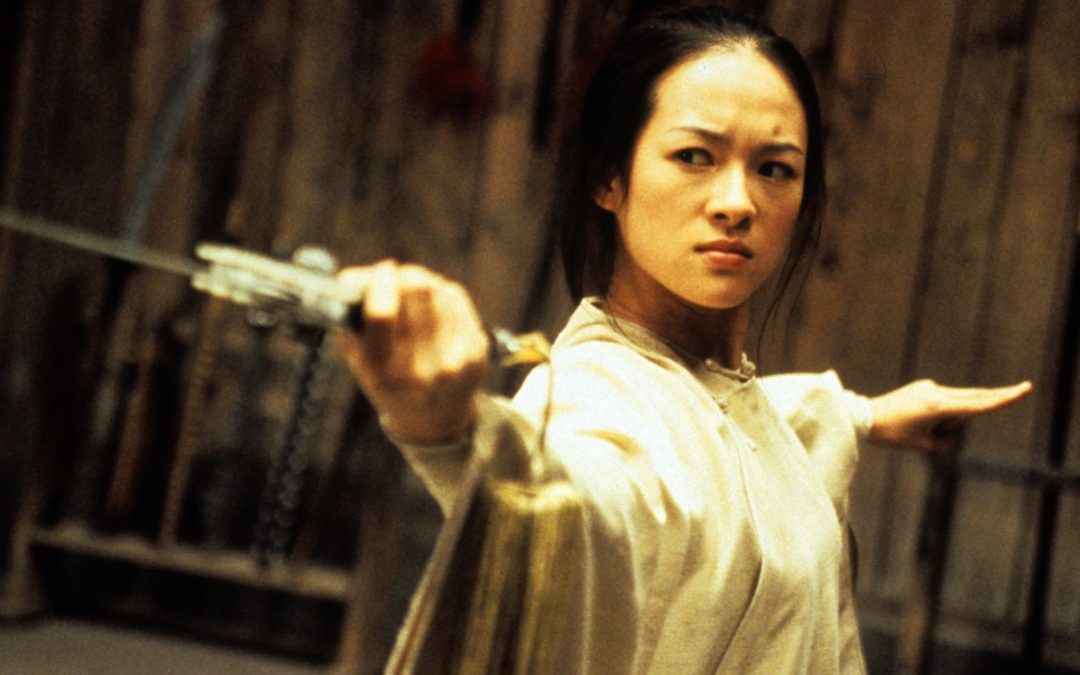Wuxia, in one form or another, has been around for nearly two millennia. The word itself – coined in the early 20th century – simplistically translates to “Martial Heroes” and Wuxia stories tell epic adventures, full of martial arts, romantic tragedy, high fantasy and eastern philosophy. Through books, poems and comics, Wuxia perpetuated through the centuries so it’s unsurprising that it made the leap into film as soon as it had an opportunity. Some of the earliest examples of Chinese cinema are Wuxia films and, to give you an idea of how epic I mean when I say epic, the (sadly now-lost) Burning Of The Red Lotus Temple (1928) clocked in at roughly 27 hours long…
As a cinematic force, Wuxia exploded in the 1960s, thanks largely to a trio of classics from director King Hu: Come Drink With Me (1966), Dragon Gate Inn (1968) and A Touch Of Zen (1971). Since then, it’s been continually reinvented, falling in and out of fashion, but never dying out. Tsui Hark repopularised it in Hong Kong for the Star Wars generation with his riotous Zu Warriors From The Magic Mountain (1983), but this, just like its elders, never made the journey to the west. There was an occasional accolade (A Touch Of Zen was nominated for the Palme D’or) and a passionate cult following for Hark’s films, but Wuxia didn’t ever look like something that could crack the mainstream outside of Asia (not that it even particularly wanted or needed to…).
Then, two millennia in, the stars aligned, the timing was right and for a brief, inexplicable but sparkling moment, Wuxia films dominated the box office all over the world. The big Wuxia films of the early 2000s admittedly split opinions among martial arts fans but it was an amazing period in cinema history just to see our beloved genre suddenly being talked about with the credit it’s always deserved, and sweeping the Oscars.
This month, as part of Den Of Geek’s ongoing exploration of martial arts films, I’m taking a look back at some of the key Wuxia films from that era to see how they’ve stood the test of time:
Crouching Tiger, Hidden Dragon (2000)
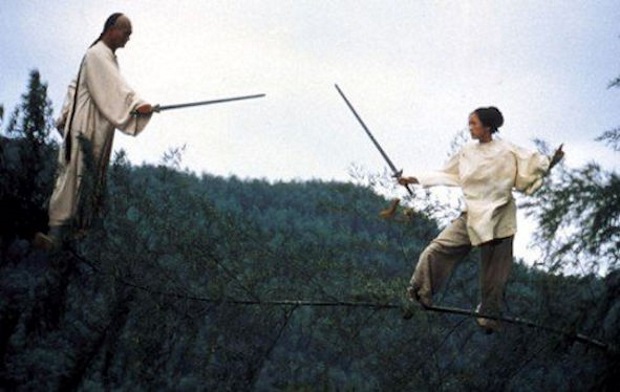
Based on a five-book series of Wuxia stories called Crane-Iron by Wang Dulu, this is the cautionary tale of the Green Destiny Sword, a hallowed weapon that brings death and/or glory to its possessor. A host of characters seek it out but at the film’s centre is an unrequited love between starcrossed sword masters, Li Mu Bai (Chow Yun-Fat) and Yu Shu Lien (Michelle Yeoh).
Taiwanese director Ang Lee was better known for drama rather than action at the time. Like many Asian directors in the mid-90s, he made the transition to Hollywood, achieving reasonable success with a trio of period pieces that included an acclaimed version of Sense & Sensibility. It may seem like an odd transition into martial arts but there’s more than a touch of Austen in Crouching Tiger, not just in the restrained simmering of forbidden love but also its exploration of a woman’s place in society, and its subsequent condemnation of oppression.
With these themes, stunning production values and a cast of legends, it wowed the critics. Chow Yun-Fat was a beloved veteran of some hundred-plus Chinese films but Crouching Tiger was the first time many in the west had seen what he was capable of. Michelle Yeoh was even more of a revelation. She’d been proving herself as a stuntwoman, martial artist and action star for years but, in Crouching Tiger, she was finally given opportunity to show her skills as an actor, earning a slew of awards nominations and balancing the vulnerability and emotional turmoil of her character with a warrior’s strength of control.
Crouching Tiger also delivered breathtaking action sequences. Western audiences were primed for this fantastical, hyper-stylised approach to action thanks to 1999’s The Matrix which shared a choreographer with Crouching Tiger in Yuen Woo-Ping. Like most of this film’s talent, he already had a string of great films to his name as a director and choreographer (he took both duties in the 1978 Jackie Chan classic Drunken Master). If The Matrix introduced his inventive, high-octane style to new eyes, Crouching Tiger allowed him to truly unleash it. The fight scenes in Crouching Tiger are a far cry from just two dudes duffing each other up. Yuen’s work is elaborate and graceful, favouring a classical cinematic magic over pugilistic realism.
That said, there’s a fair range of martial styles on display. Much of it takes inspiration from Qing gong, the Wushu technique that encourages a lightness of foot and enables martial artists to create the illusion of flight. Yuen uses wires to exaggerate this but it’s still an impressive thing to see and wowed western audiences who were quite unused to it. For those who were, the film makes a few homages to earlier Wuxia, especially King Hu’s. The treetop fight is inspired by a similar scene in A Touch Of Zen and Lee even went as far as casting the legendary Cheng Pei-Pei (Golden Swallow from Come Drink With Me) as the villainous Jade Fox.
By combining such experience and appreciation of the classics with a modern, western-friendly approach, Crouching Tiger hit the jackpot. Shot on a budget of around $17m, it made $213m worldwide at the box office and was nominated for 10 Academy Awards (4 of which it won), unheard of for a foreign language genre movie.
Perhaps part of its wide appeal lay in the fact that it was co-written by three people with very different backgrounds. James Schamus and Wang Hui-Ling had already worked with Ang Lee before but one was an American man and the other a Taiwanese woman, which makes for an interesting combination of experience. Tsai Kuo-Jung, the third writer, is an odd one as his only other film credit is 1983’s Calamity Of Snakes, one of the most reprehensible, disgusting horror films out there (and I wrote about it in my Beginner’s Guide To Chinese Black Magic if you dare to learn more). Overseen by Ang Lee, this curious team managed cinematic alchemy.
Watching it now, Crouching Tiger admittedly has its flaws. It’s overlong and – as contemporary Chinese audiences complained – a little slow at times, but when it hits, it hits hard. The beautiful visuals and evocative score by Dun Tan make it a ravishing experience and the themes of the film still resonate. Its final third stays the right side of melodrama and packs a punch to the heart. It’s by no means the greatest Wuxia ever but it brought this part of Chinese culture to eyes that would never otherwise have looked, and it’s a grandiose piece that – when viewed outside of any hype or expectation – still stands up.
Hero (2002)
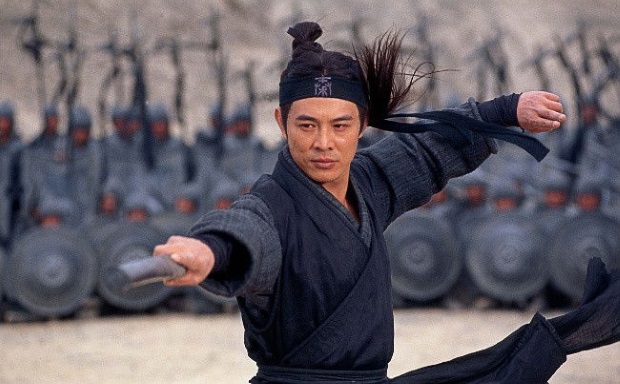
Around the time Crouching Tiger was released, arthouse director Zhang Yimou (of Raise The Red Lantern fame) was working on his own Wuxia. On hearing of the Ang Lee film, he shelved it, not wanting people to think he was just making a Chinese answer to a Taiwanese film. However, Jet Li, who’d been set to star in the lead role, persuaded Yimou to pick it up again because he loved it so much. “In my career, it’s the first script that made me cry. It’s an incredible story where drama is first and action is there to help the story,” Li explained.
While Li was already known in the west thanks to action romps like Romeo Must Die and Kiss Of The Dragon, Hero took him to the next level and showed audiences he was far more than just fists and kicks. Here, he plays a nameless fighter who arrives at the King of Qin’s palace to announce that he has killed Long Sky, Flying Snow and Broken Sword, the trio of assassins who have, for years, threatened the King’s life. No one can understand how he accomplished this – given that the killers’ combined skills are enough to take on an army – so, in a room of flickering candles, he tells his story…
This dramatic setup unfolds and is as much a story about storytelling than anything else, using twists and unreliable narrators to keep things moving. The fights – choreographed by Tony Ching – are spectacular and very different to Yuen Woo-Ping’s. Ching was one of the wildest filmmakers of the 80s Hong Kong New Wave movement and was no stranger to Wuxia. He not only made Duel To The Death (the maddest ninja movie ever) but worked with the great King Hu, helmed the Swordsman trilogy and choreographed Tsui Hark’s 1992 hyper-kinetic remake of Dragon Inn. He brings this authenticity and his trademarked energy to Hero.
The fights are heavy on wire-work but the closer you watch them, the more impressive they are. Not just for the physicality and invention but also the way Yimou ties them in with the philosophies of the film. Each section of the story has its own colour scheme, in a way that would make even Peter Greenaway tip his hat, and the fights – set against backdrops of red autumn leaves, green silks, blue waters and white rains – are more ravishing than they are violent. It’s by no means the first kung fu film to take inspiration from the Wu Xing, the Five Elements in Chinese philosophy (Chang Cheh’s Five Element Ninjas (1982) springs to mind as an example) but it channels them in one of the most elegant ways I’ve seen.
Like Crouching Tiger, the cast is a superstar ensemble. Both shared stunning newcomer Zhang Ziyi but Hero put her alongside Maggie Cheung (who’d so memorably played Jade in New Dragon Inn), Tony Leung and Donnie Yen as the assassin trio. Yen, in particular, was yet to really break the west but his brief but brooding performance as Long Sky made a huge impact. He’s now widely and rightfully regarded as one of the finest martial arts stars of all time, up there with Bruce Lee and Jackie Chan.
Hero’s political message is ingeniously ambiguous. Some of it depends on the translation of the word “Tianxia” (which plays a key part in the story and can mean “Our Land” or “All Under Heaven”) but it’s been praised for its open-minded message of love and peace by some while vilified by others for apparently promoting autocratic rulership. There aren’t a lot of action films where you can take away so many meanings but Hero is nothing if not thought-provoking.
At the time it was made, Hero was the most expensive Chinese film in history with a budget of $31m but, thanks in part to a promotional campaign headed by Quentin Tarantino, it went on to dominate the US box office, earning a worldwide total of $177m. It’s still a superb watch and a fantastic introduction to the genre for newcomers. With the theatrical version clocking in at just 96 minutes, it’s also the shortest of these films and – while it makes use of 18,000 extras (no, really) in its battle scenes – it still retains the feeling of being a lean, carefully measured film.
House Of Flying Daggers (2004)
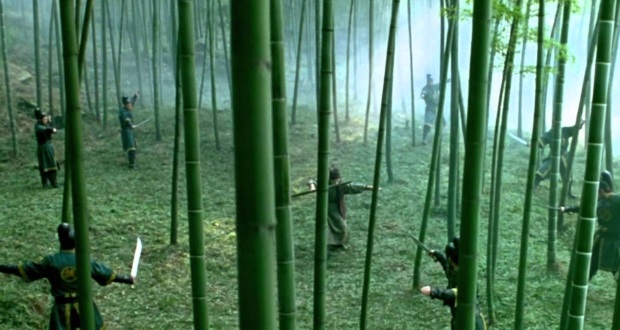
After the success of Hero, Zhang Yimou caught the Wuxia bug and planned a sequel. It was only during the writing phase that he realised it was so thematically opposed that it needed to be a completely new film.
Although its runtime sprawls, it’s a story that focuses mostly on three characters and how their doomed fates intertwine. Zhang Ziyi returns, this time as Mei, a courtesan who’s also a member of an underground revolutionary group devoted to toppling the corrupt government. Jin (Takeshi Kaneshiro) and Leo (Andy Lau) are a pair of police officers who hatch a plan to arrest her and have her lead them to her group’s headquarters… Intrigue ensues.
For me, House Of Flying Daggers feels like the best of these movies by far. It’s a staggering piece of work, every bit as visually gorgeous as Hero and Crouching Tiger but with a plot that runs deeper. The characters here are unforgettable and brought to life so well by the cast. Zhang Ziyi delivers the best performance of her career as Mei but Kaneshiro and Lau hold their own too, all wrenching as much emotion from the story’s tragic romance as they can, without ever tipping into melodrama. The film also rewards repeat watches with its symbolism (again, making use of the Wu Xing) and subtext.
Shot largely in Ukraine, it’s interesting to read more about the production and how hard the crew worked to pull off some of the scenes in the film, especially given how much of what looks like augmented FX are actually real. The final scene – an iconic showdown in the snow – wasn’t originally intended to be shot that way but, when they woke up on the morning of filming, it had snowed overnight and they had little choice. A happy accident as it fits perfectly with the chilling twist delivered right before it and gives the film one of the most visually powerful climaxes of the genre.
Shot on less than half of Hero’s budget (just $12m – although it looks infinitely more expensive), Flying Daggers rode the Wuxia wave to a worldwide box office of $93m and got a 20-minute standing ovation when it screened at Cannes. It received 9 BAFTA nominations and rave reviews, cementing Yimou’s position as the new master of Wuxia.
Fearless (2006)
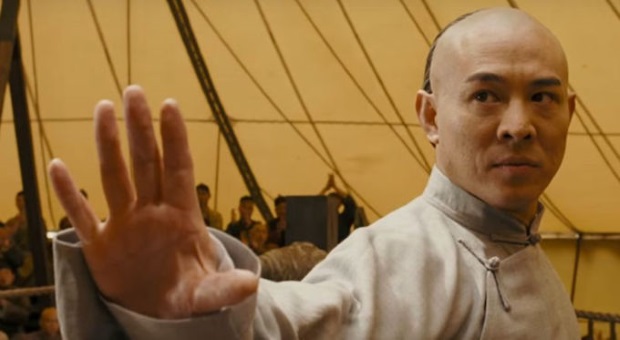
Half-Wuxia and half-biopic, Fearless capitalised on Jet Li’s success with a vehicle that puts him at the forefront of the film. He plays Huo Yuanjia, the martial arts fighter who inspired a slew of earlier films, including Yuen Woo-Ping’s Legend Of A Fighter (1982) and the Bruce Lee classic Fist Of Fury (1972). As an asthmatic underdog who learnt Wushu fighting without his parents’ knowledge, Huo Yuanjia went on to become a competition fighter, often challenging international opponents and always winning. He became emblematic of China’s strength against foreign adversity which, in the early 1900s, when China had been dubbed “the sick man of Asia” was particularly meaningful). He founded the Jingwu marital arts foundation that still flourishes now, and died from a mysterious arsenic poisoning at just 42. Perfect material for a martial heroes film!
Fearless takes some liberties with the facts and portrays Huo as an arrogant, oafish character whose actions lead to terrible tragedies. Although he’s redeemed after spending some time among nature, becoming the heroic fighting superpower we all know and love, it does feel hard to get past some of the things he’s done. He beats an innocent man to death on the guy’s birthday and, as a result, gets his own entire family killed. I mean, that’s tough to deal with, as a viewer. It was certainly tough for the surviving descendents of Huo Yuanjia who sued the producers of Fearless for defamation of character! The case was dismissed but it does leave a strange taste while watching the film.
That said, as a kung fu picture, it’s not without plenty of merit. Jet Li had planned for it to be his final martial arts film (but came out of retirement a few months later – phew!) so it contains some of his most impressive fight scenes, including a cracking David & Goliath battle between Li and Nathan “Megaman” Jones. Unlike Ang Lee and Zhang Yimou, Fearless director Ronny Yu was from a genre background. Having directed martial arts classics like Postman Strikes Back (1981) and The Bride With The White Hair (1993), it’s no surprise that the action takes centre stage here. There’s a prolonged, almost meditative section in the middle where Huo finds inner peace, but the fights come thick and fast throughout the rest of the film and are expertly choreographed by old friend Yuen Woo-Ping.
One way in which it differs from the other films in this wave, is that there’s no heroic female character in Fearless. The only woman with any real screentime is the blind peasant girl who rescues Huo and lets him work on the farm with her and, while Sun Li gives a nice performance here, the role is really just a beautiful cipher. As a result, Fearless is a more traditionally masculine film and lacks the romance that it maybe could’ve done with to make it fly like the others. It’s an earnest story with an inevitably tragic end but the attempts at emotion fall a little flat and feel schmaltzy rather than powerful. If you watch it, watch it for the fights.
Tellingly, while Fearless was another box office smash, earning $68m worldwide from eager audiences, it fared less well with critics and earned no awards nominations outside of Hong Kong.
Curse Of The Golden Flower (2007)
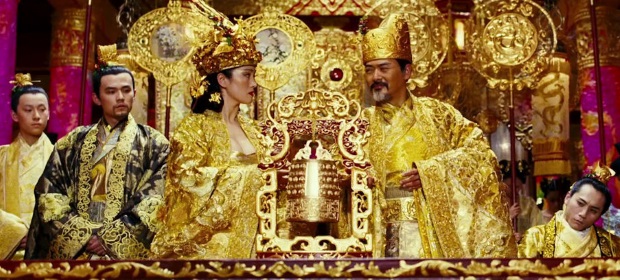
By the turn of 2007, the boom was finally fading, but that didn’t stop Zhang Yimou completing his unofficial Wuxia trilogy with the stunning and strange Curse Of The Golden Flower. This was less action-packed than its predecessors and closer to Yimou’s earlier dramas in some ways, not least of all the fact that he cast his former muse Gong Li in a lead role for the first time since 1993’s Shanghai Triad.
Yimou takes his story from the 1934 play Thunderstorm by Cao Yu, a popular, much-adapted story in Chinese film, maybe best known in the west for the fact that its 1957 film version starred a young Bruce Lee. Yimou resets the period to the Tang Dynasty and casts Chow Yun-Fat way against type as an evil Emperor who’s slowly poisoning his wife (Gong Li) with Persian black fungus in her tea. He has three sons and the film follows the various plots and counterplots of these five characters, all of whom are intent on totally screwing the other ones over.
Intrigue has always been a key ingredient for period martial arts films but here it takes centre stage. The story borders on convoluted at times as revelation follows shock revelation and evildoing follows heinous evildoing, all delivered with melodramatic flair that would make even Douglas Sirk blush. Yimou, however, carries it off in style, even injecting a little black comedy into the proceedings when it hits its highest pitches (something absent from his previous two films).
There are still some awesome action sequences – including a couple of phenomenal ninja attacks – but where Curse Of The Golden Flower shines, quite literally, is in its opulence. At $45m, it was a higher budget production than its peers and it SHOWS. It’s set almost entirely in the Imperial Palace and shimmers in golds and pinks so vivid your eyes will feel treated for having watched it, and it’s not purely ornamental either. As Yimou says, “The grandeur of the Tang Dynasty reinforces the theme of the story: power breeds evil and greed. The pomposity should not be regarded as sheer superfluousness.”
I can’t imagine working in any department involved with this film’s production. EVERYTHING is so meticulous and there’s just SO MUCH OF IT. The costumes, the sets, the photography, the editing, it all looks like it would be so daunting to even contemplate that your average human would just go “nah” and give up before they started. The fact that Curse Of The Golden Flower – easily one of the most lavish films ever created – exists is a testament to the willpower of Chinese cinema. It’s so beautiful to look at for two hours, the fact it achieves so much else feels like a bonus.
It took a worldwide box office of $79m, less impressive against the budget than its companions but still, for what’s essentially a bleak Shakespearian style drama in a foreign language, that’s an achievement. Personally, I think it’s still an great watch. Gong Li is magnificent as the Empress, the story keeps you guessing and, man, those sets and costumes. It’s a film with a lot of crossover potential to non-martial arts fans.
These five films were the most successful of their epoch but there were many others that satisfied the sudden demand for Wuxia. While it did tail off, the longer-term impact on cinema has been pronounced, with most of the players embarking on massive Hollywood careers that perpetuate to this day. Michelle Yeoh still commands a huge box office, as recent mega-smash Crazy Rich Asians can attest to; Zhang Ziyi has had her hands full in both Cloverfield Paradox and the upcoming Godzilla: King Of The Monsters; and Jet Li is preparing to play the Emperor in the live action remake of Disney’s Mulan. Additionally, the fighting style and the way the action was shot in these films became a standard for action movies, east and west.
Wuxia is still a prolific genre, producing films as diverse as Hong Kong’s Flying Swords Of Dragon Gate (2011) remake and Taiwan’s artful Cannes-baiting The Assassin (2015). Zhang Yimou made a return to the genre last year with his first English language film, The Great Wall, starring Matt Damon (!), although this met with somewhat less acclaim than his earlier work… Even Netflix got on board the Wuxia train, producing both a Crouching Tiger sequel – Sword Of Destiny (2016) – and New Legends Of Monkey, a lovely TV series based on the Wuxia classic Journey To The West. There’s still a steady stream of Wuxia that may not be setting the box office alight in the same way it briefly did, but is mostly of a high calibre.
However, even outside of a wider context, what’s impressive about this particular quintet is how well it’s aged over the past decade and a half. Audiences new and old can appreciate these grand-scale modern classics. While Wuxia is a genre firmly rooted in the past, there’s no doubt this tremendous run of films had one foot in the future.

